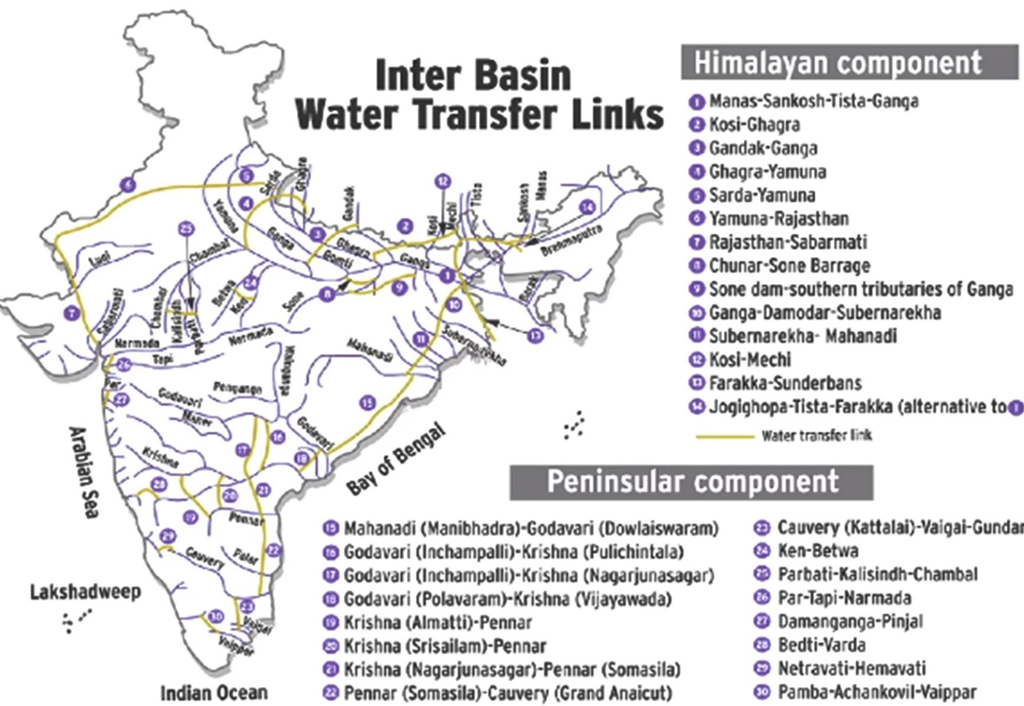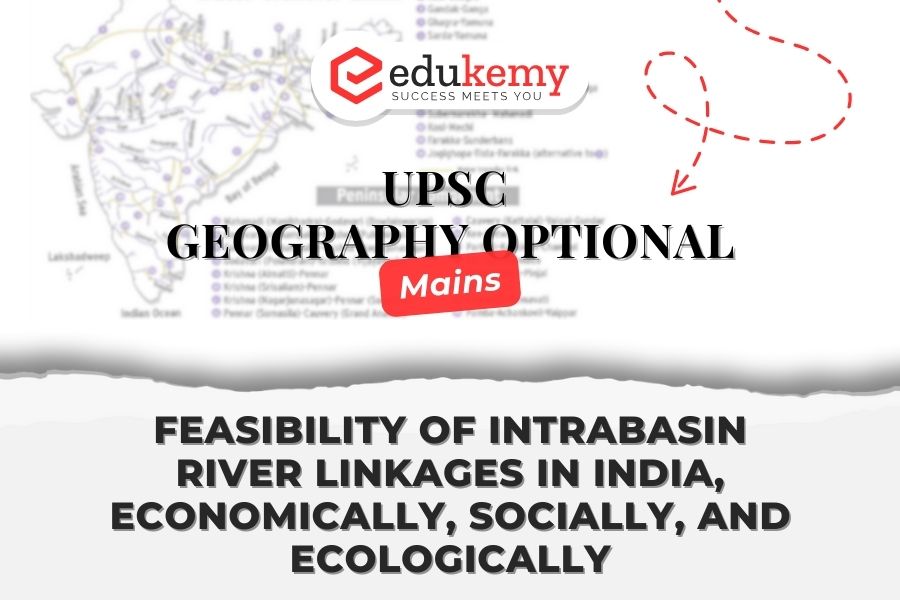
Explore the feasibility of intrabasin river linkages from economic, social, and ecological perspectives, focusing on India’s context. Analyze how connecting rivers within basins can optimize water resources allocation, enhance irrigation potential, and mitigate water scarcity challenges. Understand the socio-economic benefits of improved water availability for agriculture, industry, and drinking purposes, fostering regional development and livelihood security. Delve into ecological considerations, including impacts on river ecosystems, biodiversity, and downstream habitats. Examine examples such as the proposed Ken-Betwa river linking project and the Godavari-Krishna link in India, highlighting the complexities, controversies, and trade-offs associated with intrabasin river linkages. Gain insights into the multifaceted implications of river interlinking for India’s water management and sustainable development goals.
Contents
Answer:
Introduction:
Intrabasin river linkages refer to the interconnection of rivers within a basin or region, aiming to optimize water resource management and distribution. This concept entails the transfer of water from surplus regions to deficit regions to meet various needs like irrigation, drinking water, and industrial purposes.
Body:

Economic Feasibility:
- Optimal Resource Utilization: Linking rivers enables the efficient utilization of water resources across regions.
- For instance, India’s National River Linking Project proposes to transfer water from surplus river basins like the Brahmaputra and Ganga to water-deficit regions like the Kaveri and Godavari basins, enhancing agricultural productivity and hydropower generation.
- Boosting Agricultural Output: By providing water to arid regions, intrabasin linkages can significantly increase agricultural output.
- The linking of the Ken and Betwa rivers in India’s Bundelkhand region aims to alleviate water scarcity, thereby enhancing agricultural productivity and improving rural livelihoods.
- Mitigating Drought Impacts: During periods of drought, intrabasin linkages can serve as a crucial lifeline for communities dependent on agriculture.
- Projects like the Damanganga-Pinjal river interlinking in Maharashtra aim to mitigate the adverse effects of drought by ensuring water availability for irrigation and drinking purposes.
Social Feasibility:
- Water Security: Intrabasin linkages enhance water security by ensuring a reliable water supply for drinking, sanitation, and domestic purposes.
- For instance, the Ken-Betwa river linking project in India’s Madhya Pradesh and Uttar Pradesh states aims to provide potable water to millions of people residing in drought-prone areas.
- Conflict Resolution: By equitably distributing water resources, intrabasin linkages can help mitigate inter-state water disputes.
- The linking of rivers like the Mahanadi and Godavari in India seeks to address water conflicts between neighboring states, fostering regional cooperation and harmony.
- Socio-economic Development: Access to water through intrabasin linkages promotes socio-economic development by facilitating agricultural growth, improving public health, and supporting industrial activities.
- For example, the proposed Ken-Betwa river linking project is expected to uplift rural communities by providing employment opportunities and boosting agricultural incomes.
Ecological Feasibility:
- Ecosystem Restoration: Intrabasin linkages can aid in ecosystem restoration by replenishing depleted water bodies and rejuvenating wetlands.
- Projects like the interlinking of the Himalayan rivers in India aim to revive degraded ecosystems and conserve biodiversity by maintaining minimum ecological flows.
- Flood Management: By regulating water flow, intrabasin linkages help mitigate the risk of floods in downstream areas.
- Initiatives such as the interlinking of rivers in India’s eastern region seek to control floods by diverting excess water to less flood-prone regions, thereby safeguarding lives and property.
- Climate Resilience: Intrabasin linkages contribute to climate resilience by enhancing water availability and adaptability to changing climate patterns.
- Through projects like the Damanganga-Pinjal river interlinking, India aims to build resilience against climate-induced water stress and ensure sustainable water management practices.
Challenges:
- Environmental Impact Assessment
- Inter-State Water Disputes
- Displacement of Communities
- Cost Overruns
- Technological Challenges
- Resettlement and Rehabilitation
Conclusion:
Realizing the full potential of these projects requires comprehensive planning, stakeholder engagement, and sustainable management practices. By addressing challenges and leveraging the benefits of intrabasin linkages, countries can achieve water security, foster regional cooperation, and build resilience to climate change, ensuring a sustainable future for generations to come.
In case you still have your doubts, contact us on 9811333901.
For UPSC Prelims Resources, Click here
For Daily Updates and Study Material:
Join our Telegram Channel – Edukemy for IAS
- 1. Learn through Videos – here
- 2. Be Exam Ready by Practicing Daily MCQs – here
- 3. Daily Newsletter – Get all your Current Affairs Covered – here
- 4. Mains Answer Writing Practice – here

